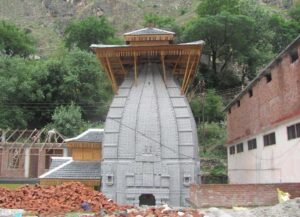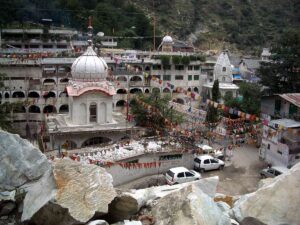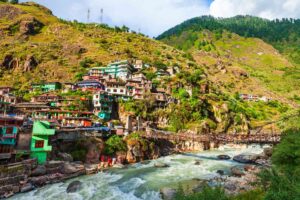About Manikaran Temple
Manikaran Temple is located 41 km from Kullu,northeast of Bhuntar in the Parvati Valley along the Parvati River in Himachal Pradesh. Visitors to this small village come to see the hot springs and pilgrimage sites in Manali and Kullu. There is also a demonstration geothermal energy plant here. Both Hindus and Sikhs value this location in the Kullu district for the same reason—finding peace—despite having different religious views. Manikaran Temple is a renowned figure in both the Hindu and Sikh religions, and is found in the Parvati Valley, which was created by the rivers Beas and Parvati. In the first, the location is connected to Lord Manu’s resettlement efforts following the “Great Flood,” while in the second, Guru Nanak, the Sikh religion’s founder, is linked to the location. As a result, there are numerous temples and a Gurudwara in this area, indicating the profound intellectual influence and charisma of these two religions.
History
Manukaran temple is the subject of numerous Hindu and Sikh mythology and legends. According to the Hindu tale below, the name of the location is thought to have originated from the Sanskrit term “Mani,” which means precious gem stones. Goddess Parvati misplaced her priceless “mani,” or jewel, when she and her husband, Lord Shiva, arrived in this region of the earth. Shiva was enraged when his soldiers failed to locate it after being assigned to do so. This sparked Tandava, who invoked the corrosive forces of Nature. The lost gem that Parvati owned was later returned by the serpent deity Sheshnaag.Another version of the myth claims that Sheshnag purposefully removed the gemstone from the ground, which infuriated Lord Shiva and caused Sheshnaag to erupt with hot water that is still present today in the form of nearby hot springs, along with the “mani” Parvati, despite her loss. Since then until the 1905 earthquake, the hot springs have been said to hurl diamonds.
According to Sikh legend, when Guru Nanak and his disciple Mardana arrived at the location, they were both hungry. As a result, Nanak instructed Mardana to establish “Langar,” or a communal kitchen, for everyone. Mardana began preparing Roti after gathering ingredients from surrounding homes.Nanak requested him to remove a stone from where a hot water spring rose because there wasn’t a fire to cook it on. According to his Guru’s instructions, Mardana dropped rolled chapattis into the river, but it sank. When the sunken chapattis came to the surface, Nanak instructed his disciple to pray to God for them to be baked so that they may be donated to help the hungry. Because the prayers were heard, Sikhs regarded the location as holy.
The Best time to visit

The year-round climate in Manikaran Temple is pleasant. April to last till June is the best months to visit Manikaran Temple.
Architecture of manikaran Temple

Amazing architectural genius may be seen in the Gurudwara Manikaran Temple. Traditional Sikh and Hindu architectural styles are combined in the building. The main complex is decorated with stunning domes, detailed carvings, and vivid murals that reflect events in Sikh history. The Gurudwara’s gilded exterior glistens in the sunlight, emphasising its magnificence.Amazing architectural genius may be seen in the Gurudwara Manikaran Temple. Traditional Sikh and Hindu architectural styles are combined in the building. The main complex is decorated with stunning domes, detailed carvings, and vivid murals that reflect events in Sikh history. The Gurudwara’s gilded exterior glistens in the sunlight, emphasising its magnificence.
Significance
The Gurudwara Manikaran Temple holds a special place in the Sikh religion. The location where Guru Nanak taught Dev Ji is revered as a sacred space. The Gurudwara acts as a spiritual hub that upholds the values of devotion, selflessness, and equality. Visitors to this holy place come to ask for blessings, take part in prayers, and spend some time in introspection.
How to Reach

Road access is available from a number of towns in Himachal Pradesh to Gurudwara Manikaran Temple. Kullu, which is easily accessible by both air and road, is the closest large city. Aproximately 35 kilometres (22 miles) distant, Bhuntar Airport is the closest airport. You can take a bus or a taxi from Kullu and Manali to Manikaran Temple. A sizable parking lot is available for private vehicles once you arrive at Manikaran. After that, go over the bridge that connects you to Manikaran Temple . A 500-meter distance away bridge can be found.
1.By Rail: Buses to Kullu and Manikaran Temple are readily available from Chandigarh, which is home to the closest railway station.
2.By Road: Kullu is connected to a number of cities and towns, making it easy to travel there from Manikaran Temple .
Beautiful places to visit manikaran

1.Malna– Twenty km north of Jari, on a mountainside, sits the isolated settlement of Malana. Despite being the most remote village in the area, the residents of this town seem to wish to remain insular. The people that live in this town identify as “Alexander The Great’s” army ancestors.They take pride in claiming to be the oldest democracy in the world while living a different lifestyle, speaking their own language, and having a fully functional parliamentary system with a court, prime minister, and president. Outsiders are not permitted to interact with the temples, the villagers, or their possessions. When visiting Malana, it is a good idea to bring a guide.
2.Parvati valley – The beginning of the Parvati Valley is in Bhuntar, which also acts as the entrance to this alluring beauty. As part of a trip to the Parvati valley, Manikaran offers a variety of tourist attractions. It continues to extend from Manikaran up to the huge Himalayan range, which rises to a height of 5000 metres. The mythology and folklore of God Shiva entering the valley and deciding to stay are numerous in the Parvati Valley. Hippies and travellers come from all over the world to this area to grow marijuana, which has recently been brought up in conversation.
3.Gurudwara– This gurudwara with five stories was erected in Manikaran temple in 1940, close to the Parvati River. The twelfth Guru Khalsa makes reference to the historical location. Guru Nanak Ji is supposed to have travelled there in 1574 with his disciples. This is undoubtedly the most sacred location in Manikaran Temple for Sikhs. They flock in their thousands to this gurudwara to ask for blessings and to show respect. Every day, the langar, located on the ground floor of the prayer hall, provides free, delectable meals to the underprivileged and followers. Any visitor to the gurudwara is welcome to enjoy the meal. In addition to this, the Gurudwara offers free lodging to worshippers. The two biggest festivals celebrated here are Gurupurab and Baisakhi, when innumerable followers go to this location to observe these holy festivities.
4.Kheer Ganga– The frothy milk-colored water of the river Parvati is the source of the name of a little hamlet in the Parvati Valley. It is located at a height of 3050 m and 64 kilometres from Kullu. One of Himachal Pradesh’s top trekking locations, it offers expansive vistas of clear skies and verdant valleys. Khir Ganga near Manikaran Temple has recently gained popularity as a destination for travellers seeking adventure.
Conclusion: In addition to being a place of worship, the Gurudwara Manikaran Sahib is also a haven for tranquilly, spirituality, and intergroup harmony. It attracts visitors looking for spiritual uplift because of its historical significance, architectural beauty, natural hot springs, and religious practises. A trip to the Gurudwara Manikaran Temple is an event that will ignite your soul.
FAQs
1 .How can I reach Manikaran Temple In Himachal Pradesh?
Road access is available from a number of towns in Himachal Pradesh to Gurudwara Manikaran Temple . Kullu, which is easily accessible by both air and road, is the closest large city. Aproximately 35 kilometres (22 miles) distant, Bhuntar Airport is the closest airport. You can take a bus or a taxi from Kullu and Manali to Manikaran Temple . A sizable parking lot is available for private vehicles once you arrive at Manikaran Temple. After that, go over the bridge that connects you to Manikaran Gurudwara. A 500-meter distance away bridge can be found.
2.Is there any specific dress code for visiting the temple?
there is no specific dress code enforced for visiting the Manikaran temple in Himachal Pradesh, India. However, since it is a place of worship and religious significance, it is advisable to dress modestly and respectfully. Many visitors to Sikh temples (Gurdwaras) choose to cover their heads as a sign of respect.
3.what is the best time to visit manikaran temple in Himanchal Pradesh?
March to last till June is the best time to visit manikaran temple in Himanchal Pradesh.
4.Is there any accommodation near the manikaran Temple in Himanchal Pradesh?
Since Manikaran temple is a popular pilgrimage and tourist destination, you can find various types of lodging, ranging from budget guesthouses to mid-range hotels and resorts.
5.Is the trek to Manikaran Temple difficult?
The trek to Manikaran Temple typically starts from the town of Kasol, and it takes around 1-2 hours to reach the temple on foot, depending on your fitness level and pace. The path might involve some uphill sections and uneven terrain, but it’s not extremely challenging compared to other treks in the region. It’s a beautiful trek with scenic views, and many travelers enjoy the experience.





















